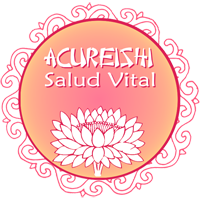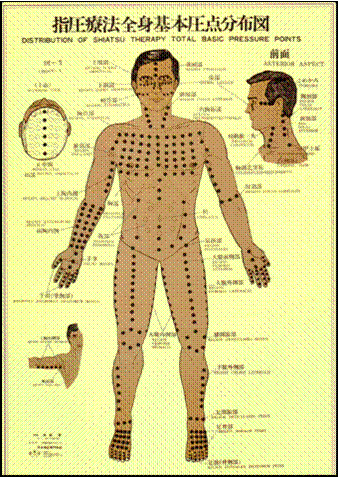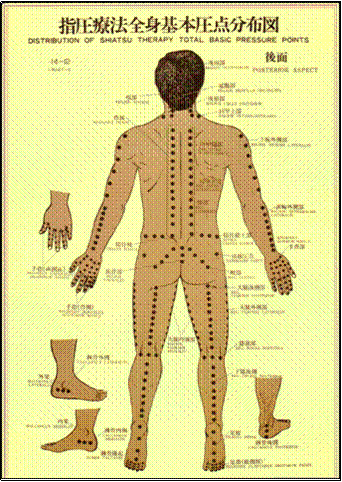History of Shiatsu
The early origins of what is now called Shiatsu back more than five thousand years in the past, when in the mountains of northern China, Taoist priests practiced the Do-In Ankyo, a form of body manipulation and revealing meditation and harmonized the vital force. With the passage of time, this technique other disciplines such as Qi Gong and various forms of martial arts were derived.
Through all sought to influence the Qi (called Chi in China, Ki in Japan and Prana in India), inseparable force of life itself and the energy considered responsible for everything that happens in the Universe, manifesting through two opposite principles while, complementary to those they called Yin and Yang.
What we know today as Traditional Chinese Medicine is basically your starting point in that preserve health oriented philosophy based on understanding and harmonization of universal energy. Within this conceptual framework subsequently different healing methods were developed, all geared directly to improving the health seeking balance in the exchange of the flow of this force and body.
Thus were born the arts as Acupuncture, el Tui-Na, Moxibustion and practices that are now more familiar to our culture, such as Tai-Chi. All, along with herbal remedies constituted, and in many cases are still, major healing methods used in China for centuries.
In the first centuries of our era and through cultural exchange, Japanese students of Buddhism monks in China observed these healing methods and taken to his home country to return. As there the practice of medicine was basically diagnosis, herbal treatments and massage practices similar to, Japanese quickly adopted these ideas. Then, with the passage of time, were adding their own points of view acquired a distinct identity and gave rise, for instance, based on prescribing herbs like Japanese Kampo treatment methods.
Chinese medicine was introduced in Japan over a thousand years ago, but the most flourishing period was from the Tokugawa period (S. XVIII) until the Meiji era (S. XIX). During that time Japan did not receive foreign influences and traditions and customs developed normally. Official medicine during this period was the Chinese (Angle) that constaba mainly Phytotherapy, Acupuncture, Moxibustion, Ammah y Anpuku. In 1827, Shiusai Ota wrote the book Anpuku, which highlighted the importance of Shiatsu in relation to the abdomen, this book is considered the foundation of Shiatsu. Towards the end of that period Anma branched into two: Anma today that was exercised by blind and was a kind of relaxing massage and Anpuku, exercised by qualified and title Kengyo, mainly specialized in curing diseases.
After the Meiji revolution, in 1867, Japan began to modernize in receiving foreign influences and political level, social and economic. Due, medical officer went so far into the background due to the impact of the new Western medicine. Titles of ancient Kampo physicians were canceled and they were forced to study the career of Western medicine. Thereby 39.000 Kampo physicians ceased to exist, because the kinds of medicine at the University of Tokyo were taught exclusively in German. Students that were basically new old medical medicine Kampo or children.
The government in the Meiji era (1867-1911) however created a school official Anma exclusively for blind people, then admitted that although his technique was less effective than Western medicine was not harmful. Around 1890 introduced into Japan Quiromasaje techniques. Anma adapted some of his theories and practice, forgetting the important basis of Oriental Medicine (tsubo, meridian, etc.) and allowed to practice since Anpuku (abdominal massage of great healing power). The reason given was that the Anpuku could be dangerous, so, Anma lost an important part of its Eastern heritage, markedly decreased effectiveness. By the year 1901 Japanese Parliament enacted a new legislation governing these activities, permitted to work only official title holders.
Thus the Anpuku survived almost clandestinely among those who did not have the official title. During this time in Japan also introduced techniques from Europe and America as Chiropractic, Osteopathy, etc.. also influenced, thus formed in what is now the Shiatsu. Despite the government's control, to 1930 There was a wide range of therapies that had been building in secret. All trying to regulate the body's energy level, This can be done in different ways. In view of this chaos and the effectiveness of treatments as there were more than 300 Different techniques, the government had to admit they were legalized again. Shiatsu was one of them. From now beginning to appear on the books and publications Shiatsu, it was becoming increasingly important over the other highlighting techniques.
Chronologically the history of Shiatsu can be summarized as:
1945.- At the end of WW2, MacArthur, occupied Japan, required all practicing Eastern methods, except acupuncture, to present a report explaining what constituted their techniques in order to legalize a new paramedical institution regarding official. The only accepted therapy, of the 300 existed, Shiatsu fue, besides Acupuncture, Ammah they rub, that had been previously accepted.
1955.- From this date the Shiatsu became known in Germany, England, France, etc., getting increasing popularity- Anma but due to its high efficiency,, and also because some foreign adopted techniques such as chiropractic. Another reason was the defeat of Japan in the war, official medicine was collapsed and badly damaged medical services. All this helped revalue Oriental Medicine.
1964.- At this time the government recognized and upgraded the Shiatsu Anma-level and Massage in the field of Manual Therapy.
1967.- At this time there is much talk radio Shiatsu, TV, etc., Namikoshi and write book “Three minutes of Shiatsu”, who got a blockbuster and collaborated appreciation Shiatsu.
Tokujiro Namikoshi, developed a method of teaching and application of Shiatsu, creating Namikoshi de Shiatsu Therapy. He was born 3 November 1905 in the prefectura of Kagawa, on the island of Shikoku; but at the age of seven, he and all his family- su padre Eikichi, his mother Masa, and firstborn Moichi, the second son Masazo, su hermano menor Haruo,y Hermano Mayor Norman- moved from the warm climate of the Seto Inland Sea to the harsh conditions of the northern Japanese island of Hokkaido. The transfer, disrupted their way of life and led to a painful journey, especially if we consider the primitive of transportation at that time. The next day after the end of your trip, mother suddenly began to complain of sore knees.
HISTORY DE TOKUJIRO NAMIKOSHI
At first everyone thought it was only as the result of long and unusual journey, and did not take their complaints seriously, but as time went, the pain became more and spread her ankles, dolls, elbows and shoulders, to become what we now call a cop rheumatism of the joints.
There was no doctor in the village where they lived. There was no medicine available. Although none of the children could tolerate watching his mother stay suffered, all they could do was take turns stroking and pressing the body parts that ached. Perhaps the desire to help children was transmitted to her, slowly as her mother began to suffer less. While caressed and massaged, often said to Tokujiro: “your hands are those that produce me feel better.” This praise encouraged the boy to work harder in the treatment of his mother. Although ignorant of physiology and anatomy, its sensitive hands and fingers warned differences in skin conditions, heat and rigidity; and he adjusted the pressure according to these variations. although initially used a 80% by rubbing 20% pressure, soon discovered that investing percentages was more effective. He concentrated on the most rigid and cold places, and soon his mother's condition improved. Since I had been pushing both sides of the middle region of the spine, I had been encouraging, unknowingly, the adrenal glands to secrete cortisol, which cures rheumatism. Finally, managed to effect a complete cure; and the experimental formation process lacks, revealed her stubborn self-healing powers possessed by the human body. He had been able to stimulate the activity of these powers, and that's how their system was born Shiatsu. After overcoming various difficulties in their study of Chinese and Western massage Anma massage, Tokujiro Namikoshi abrió a 1925, I'm Hokkaido, He Instituto of Shiatsu Therapy.
As time went, some of the people who were seeking treatment became his students. In 1933, after leaving school by those, march to Tokyo to open otro institute deShiatsu, but immediately understood that to obtain wide recognition in this technique required the cooperation of others. His devotion to this task, eventually resulted in the establishment of the Japan Institute of Shiatsu 11 February 1940. Therapy and school lectures obtained wide recognition for the unmistakably Shiatsu treatment effects. In 1955, Shiatsu first was legally approved.
Points Namikoshi supine decubitus
Points Shiatsu Namikoshi in prone decubitus







